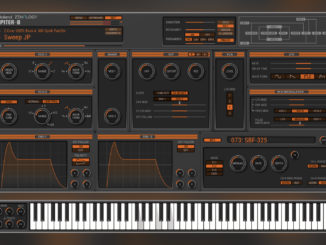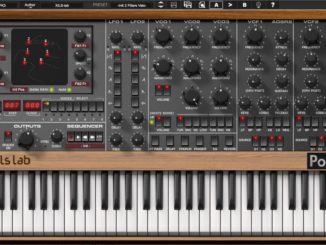GForce Software has revived the Oberheim OB-X as an officially endorsed soft synth plugin with an expanded feature set, first look, and sound demo.
In 1979, the Oberheim OB-X entered the synth world. It was Tom Oberheim’s first OB polysynth, and the first synth not based on the iconic SEM building blocks. With the OB-X, Tom wanted to offer a counterpart to the Sequential Prophet-5. As we know, he succeeded. The Oberheim OB-X and Sequential Prophet-5 went down in history and set standards in the analog polysynth market. Today, they are legendary and used by famous musicians around the world.
Queen, Rush, Paul McCartney, Prince, Depeche Mode, Simple Minds, Herbie Hancock, Chick Corea, Tangerine Dream, Jean-Michel Jarre, Susan Ciani, Japan, Eurythmics, and many more. Successors came with the OB-Xa and OB-8 and continued Tom’s synth story.
From Hardware To Software
The latest chapter is the OB-X8, a spiritual successor to these Oberheim classics that embodies all three models in a single unit. Released in 2022 and realized in collaboration with Sequential, the company they wanted to compete with in the past.
At the same time, Oberheim entered into a new alliance with Focusrite. It didn’t stop there. They also take part in the big software business. Not actively, but supporting the recreation of their mighty classics as plugins.
They officially endorse the British company GForce Software and its Oberheim emulations with the logo and name. So far, two plugins: the OB-E, a virtual replica of the Oberheim Eight Voice, and an SEM plugin.
It doesn’t stop there. Number three is here as of today. GForce Software’s newest Synthesizer plugin mimics the mighty and legendary Oberheim OB-X, again supported by the original hardware designer Tom Oberheim.
The devs provided me with a version in advance so I could take a closer look at the plugin for you.
GForce Software Oberheim OB-X
Oberheim OB-X, writing the name is a bit unusual as this is just a soft synth, not the original hardware. Thanks to the endorsement, it’s the plugin’s official name.
GForce also remains true to itself with the OB-X: a classic, detail-loving emulation but raised to a modern level with new features. When you launch the plugin for the first time, a very familiar and iconic interface welcomes the user.
A pale gray square layout, classic OB knobs and buttons, and familiar sections immediately draw you into the Oberheim sphere, in this case, the OB-X. Of course, the official Oberheim logo and lettering help here.
The developers are emulation specialists. They know what they are doing, and can already be seen in the OB-X concept. The plugin has two areas. The mid/button section is an authentic replica of the original Oberheim OB-X. The second, the top level, bears the GForce DNA with additional features.
A Classic OB-X Replica
The first section offers an accurately modeled OB-X engine in all its glory. Like the original hardware, per voice, there are two oscillators (saw/square), a 2-pole resonant lowpass filter, an amp, and two envelope generations. They also replicated the iconic classic button-based modulation section with sources and destinations.
Unlike the original with 4-8 voices, GForce gave its emulation a 16-voice boost, mono/legato/poly/unison modes, and full aftertouch support. This and the velocity can be mapped in a dedicated section and adjusted as desired. They also added a vintage control for adding subtle analog imperfections and bringing the plugin even closer to an original vintage unit.
The small but neat add-ons for the modeled engine are also nice. These bear fruit in sound design. PWM access for both oscillators gives you more sound freedom. The LFOs also now offer phase and smoothing features, making them more flexible. You can also dive deep using the individual pan control for each voice.
There are the classic Oberheim sliders to the left, and on the right, you can play with newly added freely mappable macro controllers. One parameter, no, you can put several knobs on a macro and thus take a sound entirely into a new area with just one twist. Plus, you get a new handy chord function with a scaler.
The Modern Advanced OB-X Replica
Welcome to the top level that is no longer 100% authentic but fits perfectly with the Oberheim OB-X emulation. Here, you will find elements that you know from other GForce plugins.
Modulation drilled out once again. If the “original” LFOs and ADSR envelopes aren’t enough for you, you can fall into ecstasy with the X-Modifiers. These are dedicated souped-up multi-wave LFOs and ADSRs for almost all parameters.
This should satisfy any modulation desire. These take the classic OB-X sound into new areas, even in very wild and experimental ones.
GForce’s OB-X emulation also hosts a new multi-FX section with chorus, delay, and reverb to round off your sounds. Excellent, every effect has a wide range of parameters (filtering, depth…, etc.) that are fully modulable—more than just one-click FX wonders.
Not To Forget
A simple but effective arpeggiator is also onboard, which leaves nothing to be desired. A sequencer is not available, but you can also do this in your DAW.
GForce Software delivers the plugin with 400+ sounds created by many professional sound designers. These are located in the newly designed sound browser, also available in plugins such as the Minimonsta 2 or M-Tron Pro IV. You can put the sounds here in collections, categories, types, timbres, and also mark your favorites.
First Look /Review
In practice, programming the OB-X plugin is fun and gives real Oberheim vibes. Everything is simple and immediate. Turn the knob, press the button, and something happens, just like the original OB-X from 1979 or the new OB-X8.
The sound blows you away, in my opinion. GForce Software has perfectly captured that iconic, fat, rounded Oberheim sound well all love in this plugin. Epic, smooth pads, brutal sync sounds, elegant plucks, everything is there.
Thanks to the new advanced features such as the X-modifiers you can also explore wilder sonic fields, like bizarre soundscapes, experimental pseudo-acoustic arpeggios, and more.
The synth is not lightweight on the CPU. With my relatively new Apple Silicon MacBook Air M2, the CPU fluctuates between 15% and 40%. For users with older systems, download the demo or set the plugin to the lowest oversampling level.
Overall, it’s once again a fantastic emulation of an Oberheim classic. The extra features make sense and take the whole thing to a modern level. In terms of sound, this plugin plays at a very high level, and Tom Oberheim probably also agrees with this. Otherwise, he wouldn’t endorse it and allow GForce Software to use its legendary name and logo.
Availability
GForce Software Oberheim OB-X is available now at a limited introductory price £59.99 + VAT (reg. £99.99 + VAT). An Oberheim bundle is available for an intro price of £169.99 + VAT (reg. £249.99). Existing owners of the GForce Oberheim Bundle can upgrade for £39.99 + VAT.
The plugin runs as a VST, VST3, AU, AAX plugin, and standalone software on macOS (Intel + native Apple Silicon) and Windows.
More information here: GForce Software
Available at my partner









Has the interface additions that many wanted to see on the hardware unit.
Yeah, Tom should have made a double decker / twin panel, for a broader interest in his creation. The OB-X8 is reduced to being a preset synth because the interesting knobs for tweaking are covered by a menu. Still, there is a market for synth keyboard players. Those aren’t the same as the tweakers. I can’t fault him for that.
While I agree it would have been better to have more of the page two controls directly on the front panel, it is far from a preset machine. Most of the page two controls are not exactly live tweaking controls, unless you like to chose your LFO or portamento type on the fly.
how does it compare to obsession?
can’t say didn’t test Obsession.